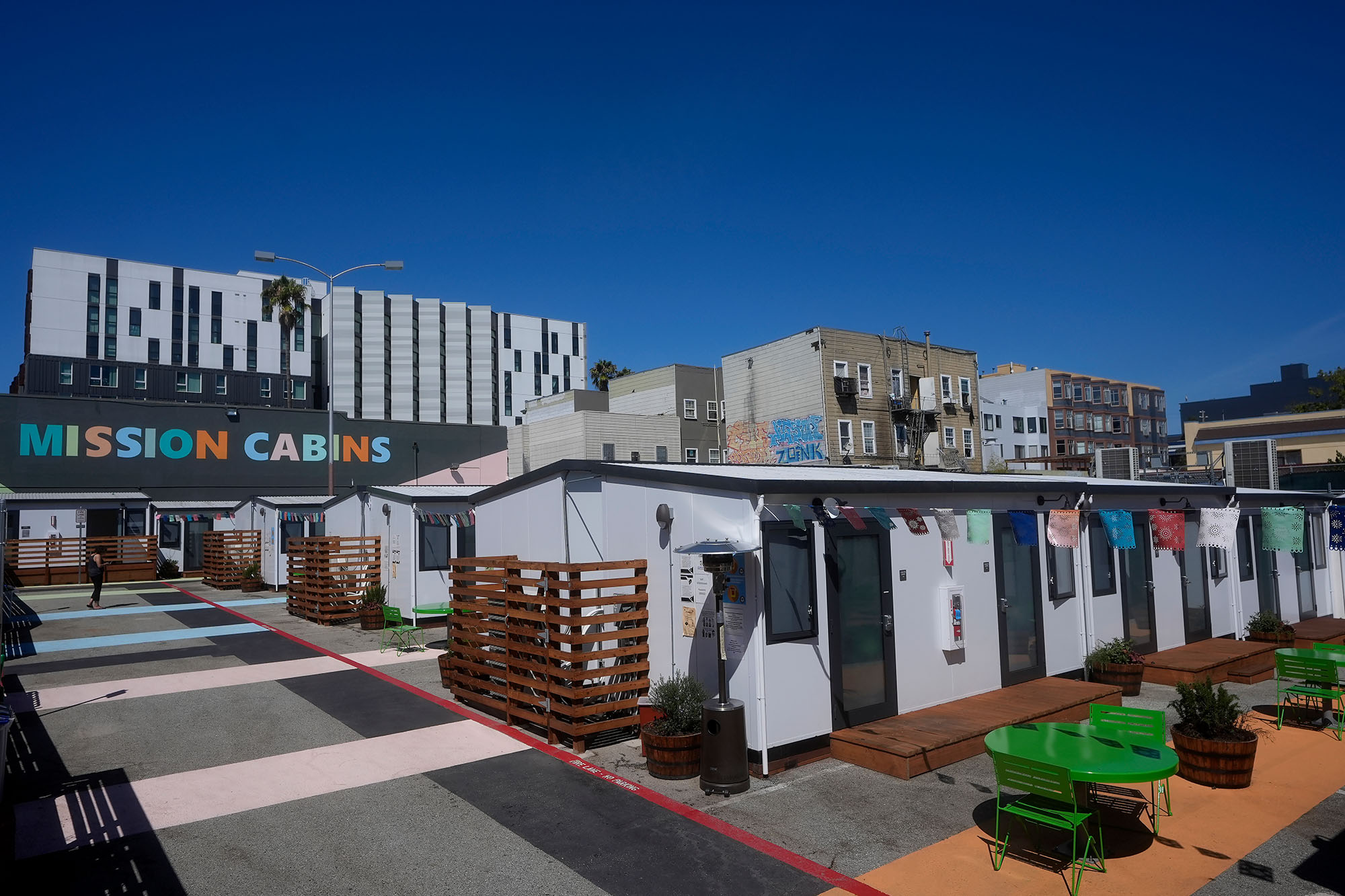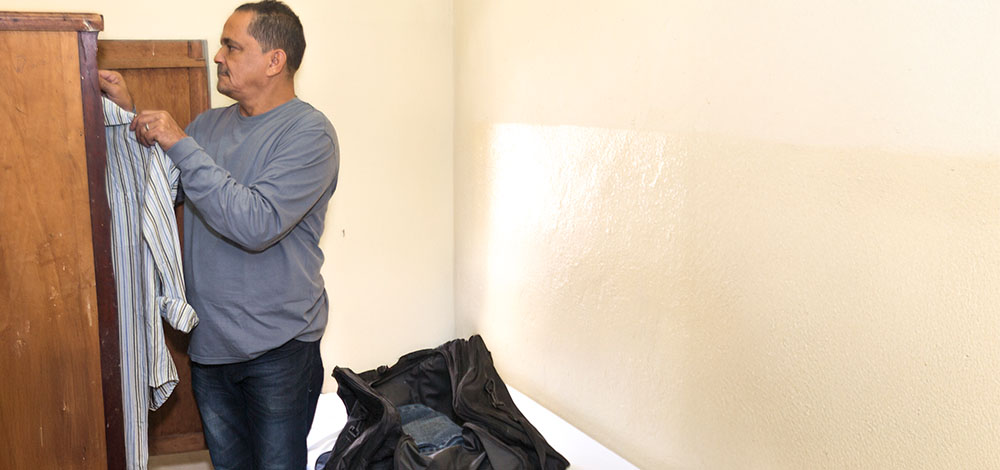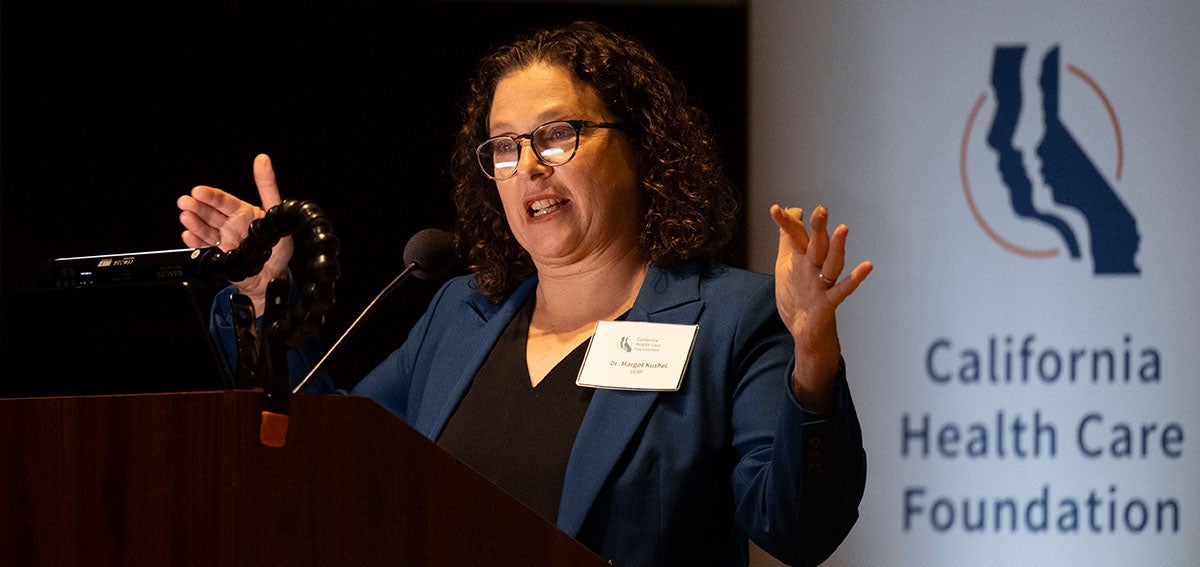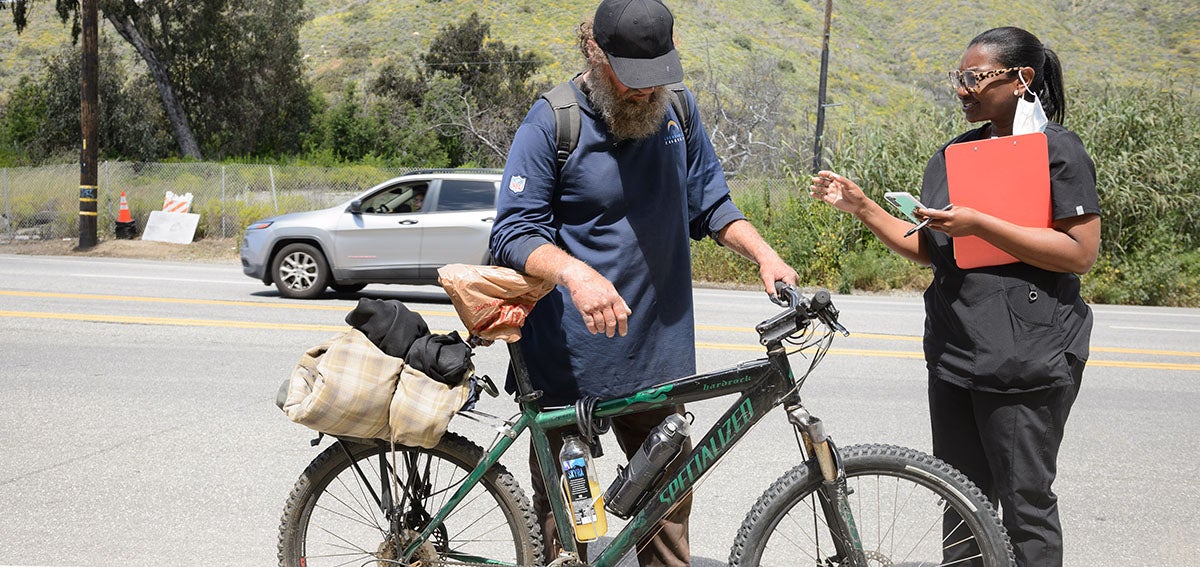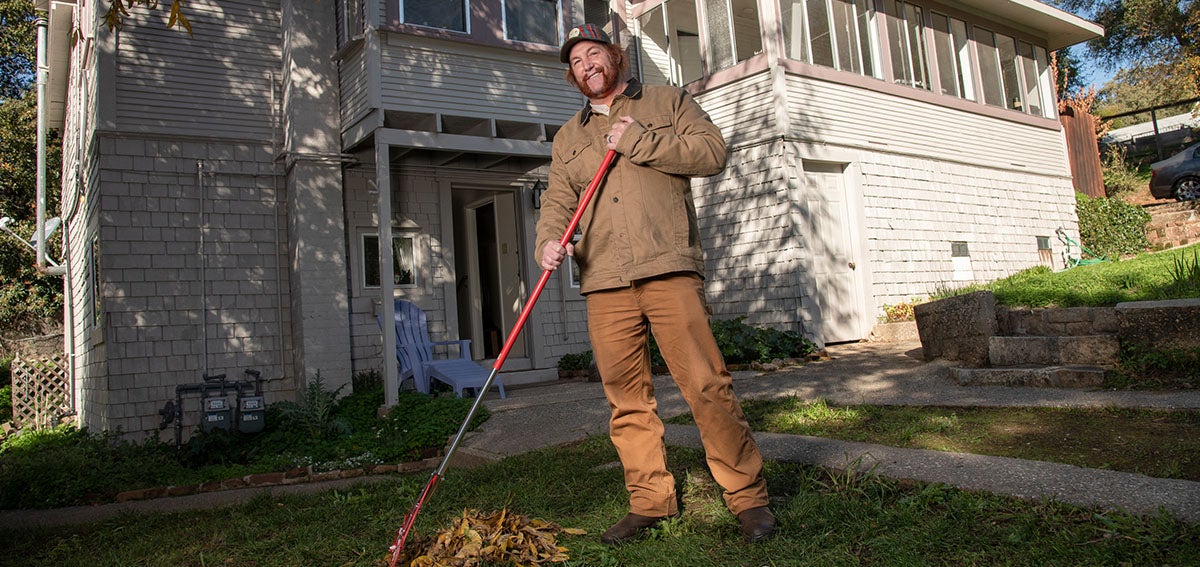
Robert Turner had been living in a tent at a campsite in Auburn during the pandemic when a hospital caseworker named Vicki Miller-Routh called out to him from her car one day. The two had connected earlier at Sutter Auburn Faith Hospital after Turner landed in the emergency room, and Miller-Routh helped him get ongoing medical care after discharge.
“She said, ‘You know what, Robert? You do not need to live like this anymore,’” Turner recalled. Miller-Routh drove Turner to the Gathering Inn homeless shelter and introduced him to two other caseworkers who helped him obtain housing, food stamps, and other help.
Turner, 53, said he was diagnosed with HIV/AIDS in 1997 and used to act and work in television production. He earned a good living in San Francisco for years, he said, before severe anxiety and post-traumatic stress disorder related to a sexual and physical assault became so debilitating that he could no longer work. Turner lost his apartment and lived on the streets.
When he moved back to the Auburn area during the pandemic to be closer to his mother, Turner found it difficult to connect with the services he needed. Yet through Miller-Routh and other caseworkers, he was able to enroll in Placer County’s Whole Person Care program, a pilot project to transform care for Medi-Cal recipients with complex needs by better connecting them to services and resources outside Medi-Cal’s traditional scope, such as food, shelter, and transportation.
Meeting those needs wasn’t easy, even with the support Turner received from the program. He couldn’t find a local doctor who took Medi-Cal and was willing to treat his HIV, so Miller-Routh connected him to a Sacramento community health clinic where he could get specialized care. She even drove him there for an appointment. Another care manager helped him find resources for transportation.
From a Tent to a Duplex
With a housing voucher for people living with HIV/AIDS, Turner said he applied to rent 32 different apartments only to be placed on yearslong waiting lists or told the voucher didn’t pay enough. Finally, a friend agreed to rent him an apartment using the voucher, and he moved in last month. His mental health needs are still unmet, as he prefers treatment without medication, and he hasn’t been able to find a provider who will adopt that approach.
“I am now housed after eight years of living in a tent,” Turner said. “The Whole Person Care project changed my life. If it wasn’t for them, I would still be out there, like, starving to death in the tent. Being homeless was dangerous.”
“These clients we picked up weren’t getting services anywhere. Having someone oversee them and help them get linked to various programs is going to make a big difference.”
—Geoff Smith, Placer County Whole Person Care program
Stories like Turner’s illustrate both the successes and challenges of California’s “Whole Person Care” experiments and highlight what lies ahead as the state plans to expand the pilots into a new and ongoing program serving Medi-Cal’s most challenging and costly patients.
Using a Medi-Cal demonstration waiver and $3 billion in state and federal money, California in 2016 embarked on a five-year experiment to integrate medical care, mental health services, housing aid, and other social supports for many of the Medi-Cal participants who have traditionally fallen through the cracks of our fragmented system. Those populations include people experiencing homelessness, people with mental illness or substance use disorders, people with two or more chronic health conditions, people who frequently access emergency rooms, and people transitioning out of incarceration.
The 25 pilot programs, mostly led by county health departments, were asked to collaborate and share data with community organizations to serve people with complex needs who voluntarily enrolled. Each pilot could prioritize different populations it wanted to serve, decide how to coordinate care for participants, and choose which services to provide, including those not traditionally covered by Medi-Cal.
In addition to establishing ongoing connections to medical and behavioral health care, the pilots offered assistance such as housing navigation, housing deposits, medical respite care, sobering centers, and services that give people a safe place to recover and find stability during a crisis.
Many Ways for Pilots to Improve Care
In their preliminary evaluation (PDF) of the Whole Person Care pilots, published in 2019, UCLA researchers found that the pilots provided better care to participants on several measures: “improved rates of follow-up after hospitalization for mental illness, initiation and engagement in alcohol and other drug dependence treatment, timely provision of comprehensive care plans, and suicide risk assessments.”
The whole-person care approach is simple, and it’s not new: Medi-Cal can better serve the people who need services across multiple systems by addressing all their concerns, including housing, food, transportation, and other basic needs. It’s part of the national conversation about social determinants of health — the social needs and economic conditions that deeply affect people’s physical and mental health. That conversation has only intensified amid the pandemic and reckonings over racial justice and income inequality.
The pilot projects will end this year. Pending federal approval in early 2022, they will be replaced by a statewide Enhanced Care Management benefit and a set of optional Community Supports benefits to be overseen by the public and private managed care organizations that serve about 83% of Medi-Cal participants.
The Enhanced Care Management benefit is a key part of CalAIM, the state’s long-planned and extensive revamp of Medi-Cal. The benefit will be offered to 12 high-need populations of focus and will help coordinate access to 14 different wraparound community supports that provide cost-effective alternatives to emergency department visits, hospitalizations, and nursing home stays traditionally covered by Medi-Cal. The reform initiative will happen over several years and will cover what services Medi-Cal provides, how they’re delivered, and how they’re paid for.
Given the diversity of approaches used in the pilots, there is not perfect overlap in the populations or services, but the new programs were designed to transition the temporary, localized pilots to something more permanent and statewide. The success of that transition depends first on federal approval of the state’s Medi-Cal waiver and also on the ability of plans to integrate existing Whole Person Care patients into an entirely new program, an especially daunting feat given the short turnaround time.
What the Pilot Partners Learned
For the more than 500 partners involved in the pilots, the transition to CalAIM is top of mind. Many have been reflecting on what they have learned, with the idea of informing their own transition and helping communities new to this work.
One of the biggest challenges for most pilot programs is a statewide lack of low-income housing. Medi-Cal, which cannot be used to pay for housing, can’t solve that problem (PDF).
“Housing navigations are more successful if you have somewhere to navigate [clients] to,” Alameda County pilot director Jennifer Martinez said. “We do have housing supports. We’ve tried to be as creative as we can with all these complicated funding sources to weave them together knowing that Medi-Cal doesn’t apply for everything.” Robert Turner is just one of 550 participants in Placer County’s Whole Person Care program, about 180 of whom found or were placed in permanent housing, said program director Geoff Smith. Indeed, one of the biggest challenges for most pilot programs is a statewide lack of housing for those with low incomes.
Although other counties faced significant challenges enabling government agencies and local nonprofits to share data on their clients, Placer was small enough to make it work, Smith said. The county has about 400,000 people.
“We have our silos, but people know each other well enough to figure things out,” Smith said. “We were able to work through it.”
“The Whole Person Care pilots opened doors for people to work together who previously haven’t been able to. . . . The pilots set them up for success.”
—Amanda Clarke, California Health Care Safety Net Institute
Smith worries about whether the county can handle bigger caseloads after the Enhanced Care Management benefit starts next year, but he is reassured that the new relationships his agency has built with local social services nonprofits will make success likelier, he said.
“These clients we picked up weren’t getting services anywhere. Having someone oversee them and help them get linked to various programs is going to make a big difference” compared to no services at all, Smith said. “If it’s about prevention, you can handle higher caseloads.”
Points of Reflection
In Ventura County, Deanna Handel, manager of the county’s Whole Person Care pilot project, found a key to success in offering services to clients at just the right time, when they were ready to accept help or make a change — such as after an emergency room visit.
“It’s like a point of reflection or vulnerability” for participants, Handel said. Looking forward, Handel hopes the county can expand clients’ electronic health records to the point where they can ping community health workers to act when one of those “reflection points” surfaces.
Successful community health workers could be found at many nonprofits, and those who have lived experience often connect better with potential participants, Handel said. She recalled a particularly effective staffer who was in recovery and had formerly experienced homelessness.
“He was the best — [clients] never said no to him,” Handel said. “This is a team of great compassion. They’ve really grown into these roles.”
The new relationships built by the Whole Person Care projects among county agencies, health care providers, and social service agencies need continued nurturing, said Amanda Clarke, director of programs for the California Health Care Safety Net Institute, which has provided technical assistance to the pilots.
“You have to be collaborative or it’s not going to work,” she said. “The Whole Person Care pilots opened doors for people to work together who previously haven’t been able to. That’s not to say it’s easy or people were [singing] kumbaya, but the pilots set them up for success.”
As the pilot projects entered their final year in 2020, the pandemic seemed like it might stop them in their tracks. The opposite was true. As Ventura County’s Handel noted, the relationships established by the pilot enabled officials to quickly mobilize services to help participants survive the year, including temporary housing through Project Roomkey, unemployment benefits, and medical respite services.
Birth of the Community Health Record
While some counties ran their pilot projects through their health agencies, Alameda County took a different approach by having the county’s two Medi-Cal managed care plans lead care coordination efforts, Martinez said. The county worked with the plans to create a kind of community health record that would give various providers crucial background information when helping clients with social or medical services.
That required encouraging community organizations to step out of their comfort zones and think in a collaborative, interdisciplinary way, Martinez said. But it also raised another concern: What, exactly, should be done with all that new information?
When Martinez asked those organizations about their biggest challenges, “everybody told me, ‘gaps in data, if you could just tell me who the [client’s] housing provider was, or who their mental health care manager was, that would make such a huge difference, it would save me all this time,’” she said.
“And then we built this community health record, and people were excited. And then they looked back at us and said, ‘So what do you want me to do with it?’” Martinez said. “We have really seen the need for very specific program guidance.”
The pilot program “really helped us in understanding the best ways to bring what we now call Enhanced Care Management with a lot of additional kinds of wraparound services — things that Medicaid historically hasn’t covered — to [high-needs] individuals,” said Jacey Cooper, director of the Medi-Cal program, in an interview. “It really was the foundation for a lot of the components of CalAIM.”
And just getting the idea of whole-person care into 25 communities has been helpful, pilot leaders noted.
“The whole-person approach, based on people’s strengths and trauma-informed — they’re buzzwords, but they shouldn’t be. They should be a paradigm for the way things are done,” said Geoff Smith of Placer County. “I really wish people understood providing these kinds of services actually costs less money. I’m excited about where CalAIM is headed.”
Barbara Feder-Ostrov conducted field interviews for this story.
Authors & Contributors

Melora Simon
Associate Director, People-Centered Care

Salgu Wissmath
Salgu Wissmath is a nonbinary photographer based in Sacramento, California. Their personal work explores the intersections of mental health, queer identity, and faith from a conceptual documentary approach. Salgu recently completed a master of photography degree at Ohio University and is currently freelancing for editorial publications and nonprofits in Northern California.

